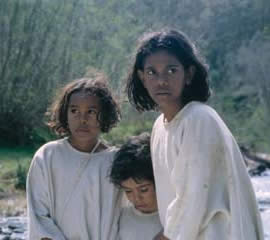Rabbit-Proof Fence
Phillip Noyce
4 February 2002
From left to right:
Laura Monaghan as Gracie Fields
Tianna Sansbury as Daisy Kadibil
Everlyn Sampi as Molly Craig“What if the government kidnapped your daughter?”
This was one of the taglines for the 2002 libertarian drama, Rabbit-Proof Fence, directed by Phillip Noyce and based on a true story. The film tied with Minority Report to win the 2002 Miss Liberty Award for Best Libertarian Film. According to Miss Liberty, libertarians enjoyed Rabbit-Proof Fence “for its touching depiction of a young girl’s heroism in the face of government oppression.”
It’s 1931, and we are in Australia. European settlers have come to the island and, regardless of the desires of the Aboriginal peoples, set up a powerful state apparatus that treats them less like humans, and more like problems for the paternalistic establishment to solve. Thus, food rationing is put into effect, and A. O. Neville, the Chief “Protector” of the Aborigine Populace, enforces the racist “Aborigines Act.” This Act allows the state to kidnap “half-castes” (those of half Aboriginal and half white descent) from their parents and force them into re-education camps where they are to be “civilised” and thus assimilated into white culture. Those half-castes with pale-enough skin will, after being “civilised,” be married to a white person, with the objective of producing even whiter children; those half-castes whose skin is not pale enough will instead become domestic servants to white families.
As Jon Osborne points out,
One of the things that so often makes government cruel is physical distance. The people who create law and the bureaucrats who interpret it are in a faraway place, well-defended against troublesome protest and remote enough not to see and feel its full effects. That’s the only way to understand the actions portrayed here of A. O. Neville…. So far away, Neville likely did not see such girls being ripped from their weeping mother’s arms, or hear the unending wail of a parent’s loss, or see the huddled, terrified girls carried away by train.
The story centres itself around three young girls in particular: Molly Craig, age fourteen; her sister Daisy Kadibil, age eight; and their cousin Gracie Fields, age ten. All three are half-castes, and on Mr. Neville’s command, are kidnapped by the state. Needless to say, their mother and others in the community are distraught. The government employee tasked with the job of actually performing the kidnapping tries to assure them that the kidnapping is okay because he has the proper paperwork—as though having the “proper paperwork” makes his violent act one iota less unethical or degrading.
As the Ludwig von Mises Institute points out, “Mr. Neville’s chilling words sum up the view of the ruthless social engineer: ‘We face an uphill battle with these people—especially the Bush natives—who have to be protected against themselves. If they would only understand what we are trying to do for them.’” But the children do not want Mr. Neville’s “help”; they do not want to be wards of the state. And so, at the urging of brave, young Molly, they plan their escape, and begin a journey back home through the Australian outback, a journey exceeding a thousands miles in length. The entire time, they are chased by government thugs.
JoAnn Skousen, in the August 2003 edition of Liberty (vol. 17, no. 8), writes,
Determined to return to their mothers, the three manage to escape and hide from bounty hunters for weeks as they make their way home by following the coast-to-coast fence erected to keep rabbits from invading and destroying the crops and pasture land on the other side.
Ironically, these proliferating rabbits were not indigenous to Australia, but were brought there as a food source by British settlers who did not realize that on a continent without natural predators, rabbits would multiply and quickly become a threat to every living plant. More ironic still is the fact that most of these children were fathered by men sent to build the rabbit-proof fence. The film’s metaphoric title reminds viewers that the white settlers were also invaders, “multiplying like rabbits” until they covered the continent. No fence was rabbit proof enough to keep them out (p. 51).
The Chief “Protector” is played by Kenneth Branagh, “who plays the part of the villain,” according to James Berardinelli, “with a charm and sincerity that is chilling. Mr. Neville is not evil personified—he is just horribly misguided. And that causes him to be more frightening than even the most over-the-top motion picture psychopath. Branagh’s low-key approach makes this the most insidiously terrifying individual he has ever portrayed.”
Still more impressive, the young actresses playing the three girls perform their roles perfectly. Berardinelli describes Everlyn Sampi’s performance as Molly as “unaffected and memorable. We never once see defeat in her eyes—only determination and defiance. Sampi makes us believe that if anyone can do the impossible, it is Molly.”
And, as Jon Osborne concludes,
This touching and inspirational true story is told with warmth and attention to detail. The child actresses who play the kidnapped girls are not professionals but untrained Aboriginal children. The use of local nature sounds and Aboriginal music also add much to the sense of realism. In less skilled hands, this epic story might have been trivialized into a two-dimensional Hollywood style racially-focused melodrama, but instead this has the feel of history, told from the perspective of a heroic and independent young girl who overcame the injustice of her times. This film swept the Australian Film Institute Awards and has been nominated for more than nineteen well-deserved awards worldwide.
Click Here to View the Trailer
Click Here to Watch the Feature Film
